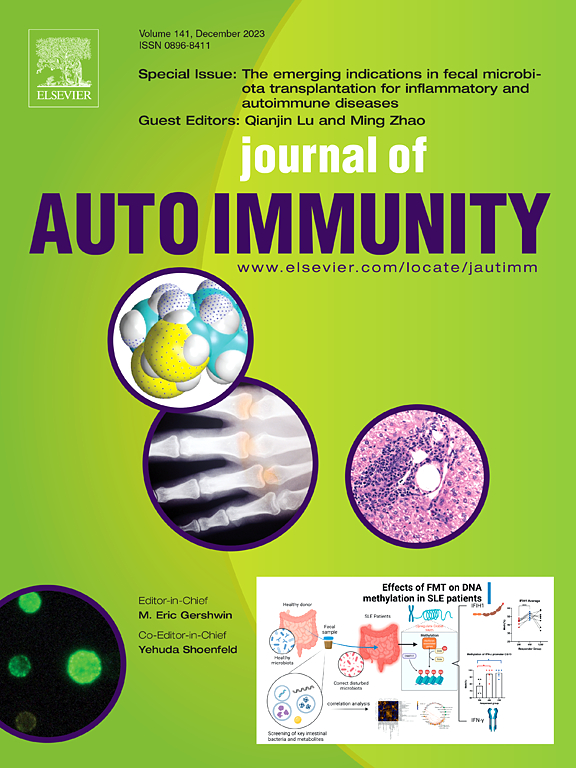miR-143-3p促进细胞外囊泡,改善局限性硬皮病真皮纤维化
IF 7
1区 医学
Q1 IMMUNOLOGY
引用次数: 0
摘要
局限性硬皮病(LoSc)是一种以皮肤广泛纤维化为特征的自身免疫性疾病。由于其严重程度和认识有限,迄今为止尚未开发出有效的治疗方法。在我们之前的研究中,骨髓间充质干细胞(BMSCs)衍生的细胞外囊泡(EVs)已被证明对LoSc小鼠模型有良好的治疗作用。然而,确定ev的靶点和潜在机制仍然是治疗应用的重大挑战。miR-143-3p是通过miRNA测序发现的bmsc - ev中一个关键且丰富的因子,在LoSc小鼠模型中介导抗纤维化作用,在LoSc患者真皮中明显缺乏。该microRNA抑制肌成纤维细胞形成和胶原合成,有助于bmsc - ev在LoSc小鼠模型中的治疗作用。此外,与正常bmsc - ev相比,mir -143-3p增强的bmsc - ev表现出更强的治疗效果,减少真皮增厚、胶原沉积、成纤维细胞分化为肌成纤维细胞,促进皮肤组织重塑。IGF1R在LoSc皮肤中高表达,被认为是miR-143-3p的潜在靶标,并被miR-143-3p增强的ev抑制,从而调节IGF1/IGF1R- akt /MAPK通路。总之,mir -143-3p富集的ev可能是治疗LoSc真皮纤维化的更有效的候选者。本文章由计算机程序翻译,如有差异,请以英文原文为准。

miR-143-3p boosts extracellular vesicles to improve the dermal fibrosis of localized scleroderma
Localized scleroderma (LoSc) is an autoimmune disease that features extensive fibrosis of the skin. Due to its severity and limited understanding, no effective treatments have been developed to date. Bone marrow mesenchymal stem cells (BMSCs) derived extracellular vesicles (EVs) have been demonstrated promising therapeutic effects on the LoSc mouse model in our previous study. However, identifying the targets and underlying mechanisms of EVs remains a significant challenge for therapeutic applications. miR-143-3p, a critical and abundant factor in BMSC-EVs identified through miRNA sequencing, mediates antifibrotic effects in a LoSc mouse model and is significantly lacking in the dermis of LoSc patients. This microRNA inhibits myofibroblast formation and collagen synthesis, contributing to the therapeutic effects of BMSC-EVs in the LoSc mouse model. Moreover, miR-143-3p-reinforced BMSC-EVs demonstrated enhanced therapeutic efficacy compared to normal BMSC-EVs, reducing dermal thickening, collagen deposition, fibroblast differentiation into myofibroblasts, and promoting skin tissue remodeling. IGF1R, highly expressed in the skin of LoSc, was identified as a potential target of miR-143-3p and was inhibited by miR-143-3p-reinforced EVs, thereby modulating the IGF1/IGF1R-AKT/MAPK pathway. In conclusion, miR-143-3p-enriched EVs could be a more efficient candidate for treating dermal fibrosis in LoSc.
求助全文
通过发布文献求助,成功后即可免费获取论文全文。
去求助
来源期刊

Journal of autoimmunity
医学-免疫学
CiteScore
27.90
自引率
1.60%
发文量
117
审稿时长
17 days
期刊介绍:
The Journal of Autoimmunity serves as the primary publication for research on various facets of autoimmunity. These include topics such as the mechanism of self-recognition, regulation of autoimmune responses, experimental autoimmune diseases, diagnostic tests for autoantibodies, as well as the epidemiology, pathophysiology, and treatment of autoimmune diseases. While the journal covers a wide range of subjects, it emphasizes papers exploring the genetic, molecular biology, and cellular aspects of the field.
The Journal of Translational Autoimmunity, on the other hand, is a subsidiary journal of the Journal of Autoimmunity. It focuses specifically on translating scientific discoveries in autoimmunity into clinical applications and practical solutions. By highlighting research that bridges the gap between basic science and clinical practice, the Journal of Translational Autoimmunity aims to advance the understanding and treatment of autoimmune diseases.
 求助内容:
求助内容: 应助结果提醒方式:
应助结果提醒方式:


